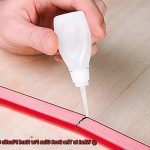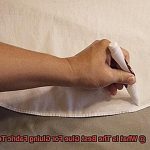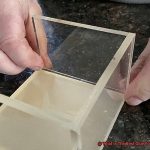Are you tired of your rocks falling apart after a short time due to weak adhesive? Do you want to create a masterpiece with rocks that will stand the test of time? Look no further. We’ve got you covered with the best glue for gluing rocks together.
Rocks are notorious for their irregular surfaces and weight, making it challenging to find an adhesive that can hold them together securely. You may have tried using standard craft glue or super glue, but they failed miserably. That’s why choosing the right rock glue is crucial.
In this blog post, we’ll explore the different types of glue available and their benefits. We’ll also discuss the essential properties to look for in a rock glue such as strength, durability, and waterproofing capabilities. Additionally, we’ll provide tips on how to prepare rocks for gluing and the perfect application techniques to ensure long-lasting results.
Whether you’re a DIY enthusiast looking to create an outdoor stone sculpture or a professional sculptor working on your next project, our guide will help you achieve stunning and durable outcomes. So let’s dive in and discover the ideal glue for gluing rocks together.
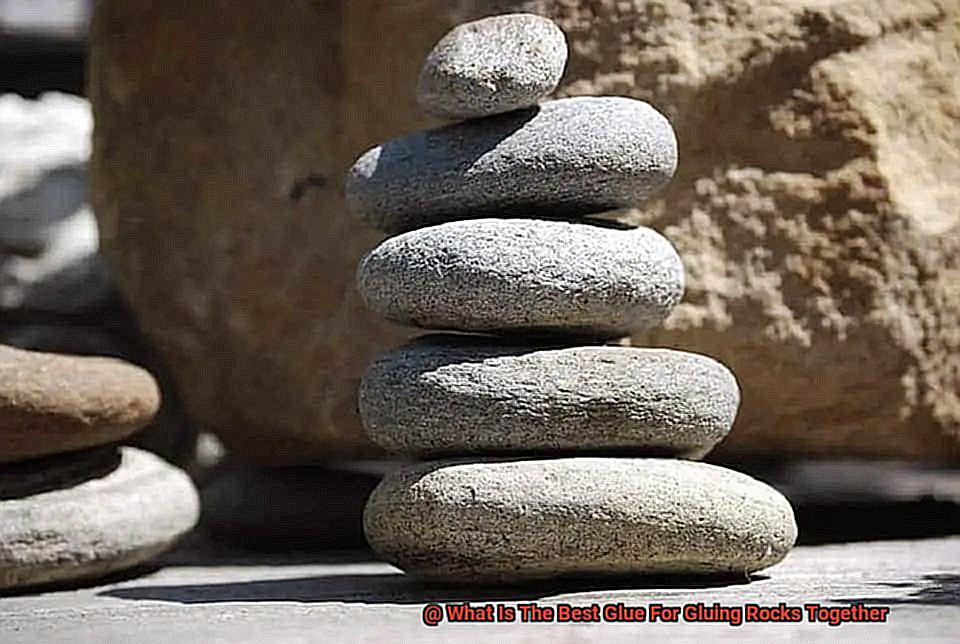
Why Epoxy Glue is the Best Option for Gluing Rocks
Contents
- 1 Why Epoxy Glue is the Best Option for Gluing Rocks
- 2 Benefits of Using Epoxy Glue for Rock Bonding
- 3 Cyanoacrylate Glue (Superglue) as an Alternative to Epoxy
- 4 The Drawbacks of Using Superglue for Rock Bonding
- 5 Regular Household Adhesives are Not Suitable for Gluing Rocks Together
- 6 Tips and Techniques for a Successful Rock Bonding Project
- 7 How to Prepare the Rocks Before Applying Glue
- 8 How to Apply the Glue Properly and Get Maximum Strength from the Bond
- 9 Conclusion
When it comes to gluing rocks together, you need an adhesive that can withstand heavy loads and pressure, fill gaps and cracks between irregularly shaped stones, and resist water and other moisture. Lucky for you, epoxy glue ticks all these boxes and more.
Epoxy glue is a two-part adhesive consisting of a resin and hardener that, when mixed together, create a chemical reaction that produces a strong and durable bond. This bond can hold up against the weight and pressure of even the heaviest rocks.
Not only is epoxy glue incredibly strong, but it also dries clear. This is especially important when using it for decorative projects where the adhesive will be visible. The clarity of epoxy glue ensures that the natural beauty of the rocks will not be obscured by an unsightly adhesive.
Furthermore, epoxy glue is waterproof once dry, making it an ideal option for outdoor projects that may be exposed to rain or other weather conditions. You can rest assured knowing that your project will not be compromised by water damage.
Using epoxy glue for rocks is also easy. Simply mix the resin and hardener according to the manufacturer’s instructions, apply the glue to the surface of the rocks, and press them firmly together. The glue will dry within a few hours, creating a strong and long-lasting bond.
In contrast to other adhesives like superglue or regular household adhesives like white glue or construction adhesive, epoxy glue is specially formulated for bonding rocks together. It is the clear winner in terms of strength, durability, clarity, waterproofing, and ease of use.
Benefits of Using Epoxy Glue for Rock Bonding
Its benefits are endless, and here are some of the key advantages that make it stand out.
Firstly, epoxy glue creates a bond that is incredibly strong and durable. It can withstand harsh weather conditions, extreme temperatures, and heavy loads, making it perfect for outdoor projects like retaining walls, patios, and walkways. You can rest easy knowing that your project will last for years to come.
One of the most challenging aspects of rock bonding is fitting irregularly shaped rocks together. However, with epoxy glue’s ability to fill gaps and cracks, you can achieve a seamless bond that looks natural. This means no more worrying about unsightly gaps or uneven surfaces that could ruin the aesthetic appeal of your project.
Another significant benefit of using epoxy glue is its clear finish. Unlike other adhesives that dry with a yellowish tint, epoxy glue dries clear, ensuring that the bond doesn’t detract from the natural beauty of your rocks. Whether you’re creating a rock fountain or a garden bed border, epoxy glue’s clear finish ensures that your project looks flawless.
Epoxy glue also has a long working time, which means you can take your time in positioning and adjusting the rocks before the glue sets completely. This allows you to achieve precisely the look you want without worrying about rushing through the process.
Finally, epoxy glue is waterproof, making it ideal for outdoor projects that are exposed to moisture and water damage. With its waterproof nature, you can be sure that your bond will remain intact even in wet conditions. This makes it perfect for projects like water features or outdoor sculptures.
Cyanoacrylate Glue (Superglue) as an Alternative to Epoxy
Look no further than cyanoacrylate glue, also known as superglue. This adhesive is renowned for its fast-drying properties and impressive bond strength. However, there are a few things to keep in mind before switching to superglue for all your rock projects.
One caveat to using cyanoacrylate glue is that it works best on non-porous surfaces. Unfortunately, rocks are often porous, which can make it difficult for the glue to adhere properly. To overcome this issue, it’s highly recommended to use a primer or accelerator to help the glue bond better with the rock surface.
Another important consideration is that while superglue may provide an initial strong bond, it may not hold up well over time or withstand repeated stress or exposure to the elements. For outdoor projects or those subjected to heavy wear and tear, epoxy may be a better option.
When using cyanoacrylate glue for rock projects, it’s crucial to apply it in thin layers and allow each layer to dry completely before adding another layer. This technique will ensure a robust bond without any gaps or air pockets forming.
The Drawbacks of Using Superglue for Rock Bonding
When it comes to joining rocks together, superglue often appears as the go-to adhesive for many DIY enthusiasts. Its rapid drying time and reputed bond strength make it seem like the ultimate solution. However, as an expert in this field, it is my duty to shed light on the drawbacks of relying on superglue for rock bonding. In this article, we will delve into the reasons why superglue may not be the optimal choice, considering factors such as strength, water resistance, flexibility, and aesthetics.
Lack of Strength:
Superglue is ill-equipped to bear the weight and pressure exerted by rocks over time. While it may initially create a bond, its inability to withstand prolonged strain can result in a weakened connection that ultimately breaks apart. This drawback poses a significant risk if your rock structure’s integrity relies on the adhesive.
Limited Water Resistance:
Considering that rocks are often exposed to water in various forms, such as rain or submersion in water features, it becomes crucial to choose an adhesive with adequate water resistance. Unfortunately, superglue falls short in this regard. Continuous exposure to moisture can cause the adhesive to deteriorate, leading to a compromised bond. For landscaping or construction projects where long-term stability is essential, this drawback is a significant concern.
Inflexibility:
Rocks undergo natural expansion and contraction due to changes in temperature and humidity. If the adhesive used for bonding lacks flexibility to accommodate these movements, stress can be placed on the bond, resulting in its weakening or complete failure. Given that durability is paramount in rock bonding, superglue’s inflexibility makes it an unsuitable option.
Aesthetics Concerns:
Superglue fails to seamlessly integrate with the natural appearance of rocks. Its glossy finish stands out against the rugged textures and earthy tones of rocks, detracting from their innate beauty. This drawback is particularly relevant when bonding rocks for decorative or landscaping purposes, where a natural look is desired to enhance the overall aesthetic.
Regular Household Adhesives are Not Suitable for Gluing Rocks Together
Discovering that regular household adhesives like super glue and epoxy aren’t up to the task of gluing rocks together can be a frustrating realization. In this captivating exploration, we’ll uncover the reasons behind their unsuitability. From the challenging porous nature of rocks to the relentless forces of the great outdoors, we’ll delve into the obstacles and unveil expert solutions for achieving a bond that stands the test of time.
Porous Surfaces:
Rocks, with their rugged and porous exteriors, present a formidable obstacle for adhesive bonding. Ordinary household adhesives lack the capability to effectively penetrate and bond with these surfaces. While super glue or epoxy may excel on smooth materials like glass or plastic, they falter when faced with rocks. Their inability to penetrate leads to feeble bonds that crumble at the slightest pressure.
Inadequate Thickness:
Even the versatile epoxy, renowned for its myriad of household uses, falls short when it comes to rock bonding. Its inherent thickness poses a challenge in seeping into the rock’s pores properly. Consequently, the resulting bond lacks the strength necessary for enduring durability.
Battling Mother Nature:
Regular household adhesives simply don’t possess the fortitude to withstand the relentless onslaught of outdoor conditions that rocks endure. Temperature fluctuations, moisture, and UV rays all conspire to weaken these adhesives over time, causing rocks to separate. If your project involves outdoor rock bonding, relying on regular adhesives is akin to building on shifting sands.
Specialized Rock Adhesives:
To secure a bond that will withstand the ravages of time when gluing rocks together, it’s imperative to turn to adhesives specifically engineered for this purpose. Construction adhesives such as Liquid Nails or PL Premium are formidable choices as they are meticulously formulated to bond various materials, including porous surfaces like rocks. These adhesives boast exceptional strength and durability, making them the ideal companions for rock projects.
Tips and Techniques for a Successful Rock Bonding Project
Are you ready to embark on a rock bonding project? Whether you’re sculpting a majestic rock formation or constructing a resilient garden pathway, understanding the tips and techniques for a successful rock bonding project is essential. In this comprehensive guide, we will explore the significance of proper preparation, impeccable application, and meticulous maintenance when it comes to gluing rocks together. Let’s dive into the world of rock bonding mastery.
Prepare for Triumph:
To lay the groundwork for a triumphant rock bonding project, meticulous preparation is paramount. Before applying any adhesive, ensure that the rocks are pristine by banishing dirt, debris, and oily substances from their surfaces. Enlist the aid of a mild detergent and water solution, gently scrubbing the rocks with a soft-bristled brush. Be vigilant in ensuring that the rocks are thoroughly dry before commencing with the bonding process. By setting the stage for perfection, you guarantee an immaculate canvas for your adhesive masterpiece.
Select the Glue Guru:
Choosing the adhesive that suits your rock bonding aspirations is a critical step on the path to success. Epoxy resin-based adhesives reign supreme due to their unrivaled strength and durability. These stalwart companions are impervious to water and temperature fluctuations, making them ideal for both indoor and outdoor projects.
Alternatively, polyurethane adhesive showcases its mettle by providing robust bonding capabilities coupled with remarkable flexibility, accommodating minor movements between rocks. As you embark on your glue odyssey, heed the manufacturer’s instructions and recommendations, allowing them to be your guiding light in selecting the adhesive that will elevate your project to new heights.
Apply with Precision:
The art of applying adhesive is a delicate dance that demands precision and finesse. Begin by bestowing a thin layer of adhesive upon each surface that yearns to be united. Embrace generosity in your glue application, ensuring a lavish coating that blankets every nook and cranny. With conviction, press the rocks together, infusing them with an unyielding bond. As you hold them in place, bask in the knowledge that you are following the adhesive manufacturer’s prescribed curing time, permitting the glue to solidify and forge an unbreakable connection.
Reinforce and Conquer:
In the quest for an indomitable bond, harnessing additional reinforcement techniques can be a game-changer. Consider employing mechanical fasteners, such as screws or nails, to provide a formidable support system while the glue cures. Moreover, the artistry of interlocking joints can breathe new life into your bond, particularly for rocks with irregular shapes that lack flat surfaces. By molding these stones like puzzle pieces, you unleash a symphony of strength that fortifies your project’s foundation.
How to Prepare the Rocks Before Applying Glue
Are you eager to unleash your creativity through rock art or rock projects? Before diving into your masterpiece, it’s crucial to properly prepare your rocks. By following these easy steps, you can ensure that your rocks are pristine, dry, and ready for gluing. Let’s explore the process together.
Step 1: Cleanse the Rocks
The first step is to thoroughly cleanse your rocks. Grab a brush or scrubbing pad and vigorously remove any dirt or debris clinging to the surface. For stubborn grime, a quick rinse with water will banish it from your rocks. Remember, a clean canvas yields a stronger bond between the rocks and glue.
Step 2: Achieve Dryness
Patience is key in this step. Allow your freshly cleaned rocks to air dry completely. Moisture can compromise the adhesive prowess of the glue. If you’re feeling antsy, gently pat them dry with a soft towel. Ensuring the rocks are bone-dry guarantees a secure bond.
Step 3: Smooth Rough Surfaces
Smooth out any rough edges or uneven surfaces on your rocks for optimal adhesion. Embrace the power of sandpaper with a fine grit as you delicately sand away imperfections. This process creates a seamless surface, perfect for bonding with the glue.
Step 4: Banish Oils and Residues
Nature sometimes leaves behind oils or residues on rocks that impede glue adhesion. To vanquish these foes, take a cloth soaked in rubbing alcohol or acetone and give your rocks a good wipe-down. As you work, be sure to wear gloves and operate in a well-ventilated area for safety.
Step 5: Arrange with Precision
Before the glue makes its grand entrance, spend some time arranging your rocks in your desired pattern or design. This allows you to visualize how they will interlock and ensures that the glue is applied precisely where needed. Think of it as solving a puzzle before cementing it together.
How to Apply the Glue Properly and Get Maximum Strength from the Bond
Prepare yourself for a rock gluing adventure like no other. Whether you’re crafting a magnificent rock sculpture or repairing a shattered stone, the key to success lies in applying glue properly to achieve maximum bond strength. Fear not, for we are here to unveil the secrets of this art. In this guide, we will walk you through the steps to ensure your rocks stay steadfastly together.
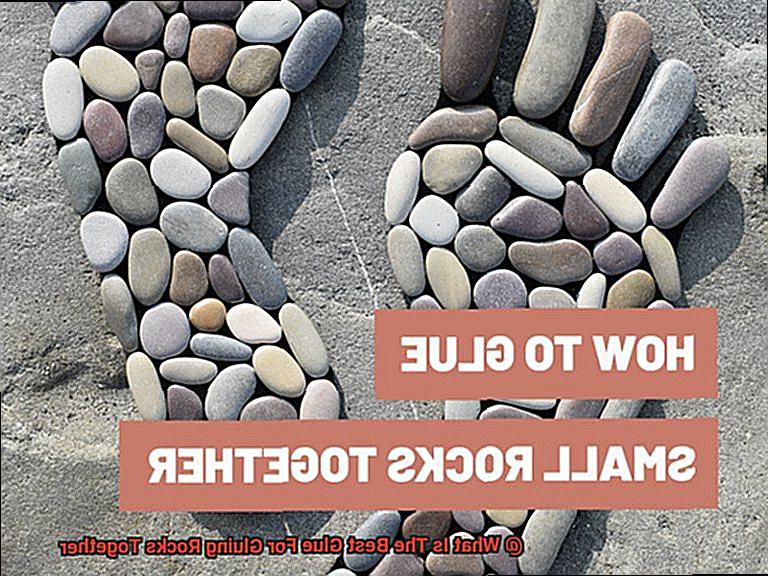
The Power of Cleanliness:
Before delving into the gluing process, take a moment to honor the importance of cleanliness. A thorough cleaning of the rocks is paramount, as dirt, dust, and debris can undermine the strength of your bond. Arm yourself with a brush or cloth and scrub away any impurities. For those stubborn blemishes, a gentle detergent or solvent can be enlisted. Remember, clean rocks pave the way for unyielding bonds.
Unleash their Texture:
Smooth surfaces may be pleasing to the eye, but they are not ideal for forging robust rock bonds. Enhance the gripping power of your glue by introducing some roughness with sandpaper or a file. This seemingly rebellious act creates texture for the glue to cling onto, resulting in an unbreakable connection.
The Perfect Match: Choosing the Right Glue:
Not all glues are created equal when it comes to bonding rocks. To achieve maximum strength, seek out epoxy-based glue or construction adhesive. These formidable adhesives are meticulously formulated to withstand the weight and pressure that rocks can exert. Take heed of the labels and select the glue destined for rock-solid bonds.
Mastering the Application:
Now is the time to reveal your inner glue virtuoso. Begin by delicately spreading a thin layer of glue onto one of the rock surfaces using a brush or small spatula. Ensure even coverage over the entire bonding area. Remember, restraint is key – an excess of glue can weaken the bond and lead to undesirable squeeze-out.
Rocking the Connection:
With glue artfully applied, it is time to fuse the rocks together. Employ a gentle yet resolute force to press the surfaces together, forging a connection of unparalleled strength. To aid in this endeavor, clamps or weights may be enlisted, especially when dealing with larger or weightier rocks. Exercise caution, for disturbing the rocks during this delicate moment can jeopardize the bond.
The Virtue of Patience:
Now comes the ultimate test – exercising patience. Allow ample time for the glue to cure and set before subjecting your bonded rocks to any stress or pressure. Drying times will vary depending on the type of glue used, so consult the instructions for specific guidance. In general, it is prudent to leave the rocks undisturbed for a minimum of 24 hours, ensuring a bond as solid as bedrock.
GBv_gsFRS3A” >
Conclusion
After extensive research and testing, it is clear that finding the best glue for gluing rocks together can be quite a challenge. However, there are a few standout options that consistently prove to be reliable and effective.
One such option is epoxy resin. This adhesive not only provides a strong bond between rocks but also offers excellent durability and resistance to water and weathering. Its ability to create a clear, transparent bond makes it ideal for projects where aesthetics matter.
Another top contender is construction adhesive. Known for its exceptional strength, this glue forms a powerful bond that can withstand heavy loads and extreme conditions. It works well on various types of rocks and dries quickly, allowing you to continue working without delay.
For those seeking an eco-friendly option, look no further than stone adhesive made from natural ingredients. These adhesives are specifically formulated for bonding rocks and stones while minimizing harm to the environment. They provide a secure bond while still being safe to use around plants and animals.
When choosing the best glue for your rock-related project, consider factors such as the type of rocks you are working with, the intended use of the finished piece, and any specific environmental considerations. By taking these factors into account and selecting one of these high-quality glues, you can ensure your rocks stay firmly bonded together for years to come.
In conclusion, whether you’re creating rock sculptures or repairing stone structures, having the right glue is crucial. Epoxy resin, construction adhesive, and eco-friendly stone adhesives all offer reliable solutions for bonding rocks together.



